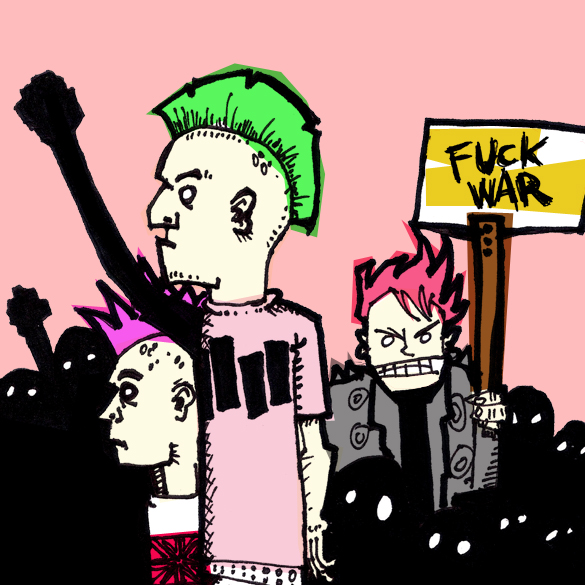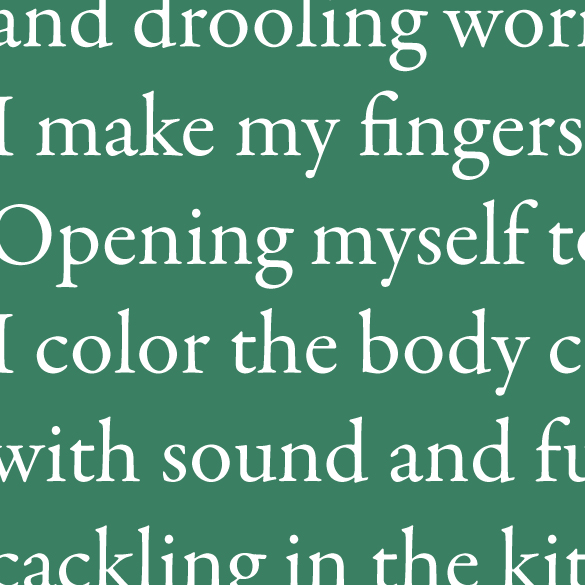In the wake of 1982’s notoriously specious Falklands War, in the ominous shadow of a nuclear stalemate, against the backdrop of the strikes and closures that resulted from Margaret Thatcher’s battle for privatization, the UK saw a new face of identity-based protest politics. Punk Rock, the symbolic disruption of popular culture that had brought glam rudely into the streets in the late 1970s, had begun to take itself seriously.
From the Sex Pistols’ chaotic calls for ‘Anarchy in the UK’ to the Clash’s Leftist guerilla act, the first generation of Punks had toyed with the aesthetics of political revolution. But some, most notably the band Crass, heard about a youth tribe spitting anarchy, and they took them at their word. They were thus sorely disappointed when they found a fancifully-dressed, provocative pop phenomenon interested only in a performance of kicking down doors, and not in what could be on the other side.
As articulate, polarizing demagogues, Crass ushered in a new era of Anarcho-Punk, using Punk’s aggressive music and subcultural mode of self-definition in service of serious radical ends. These were not bomb-hurling anarchist folk devils, nor the aesthetic provocateurs of early Punk: the new vanguard were genuinely, and at times puritanically, committed to opposing war, capitalism, religion, sexism, racism, and animal abuse. The Anarcho-Punks’ rhetoric was not dissimilar to that of certain Hippy idealists, believing in a utopian anarchist dream of a peaceful, stateless, classless, oppression-free society based on consensual mutual aid. They reinvigorated the Animal Liberation Front, as well as the Campaign for Nuclear Disarmament, which had lain relatively dormant since the 1960s. They practiced do-it-yourself living, formed collectives and squatted disused buildings, released their own records and literature, and organized gigs, direction action events, and protests.
The great public triumph of Anarcho-Punk came in the form of the Stop the City demonstration on September 29th, 1983. Long endeavoring to be more a Movement than a mere music genre or subcultural tribe, and screaming for an end to talk and a beginning of action, Stop the City seemed to be the scene making good on its promises. A flyer for Stop the City bills it as a “Protest and carnival against war, oppression and exploitation,” explaining that, “The City of London is where the arms race starts, oppression is financed and exploitation organized. Come and create a peaceful protest for life.” The goal was to disrupt the business-as-usual of the power elite with a free-form, carnivalesque demonstration, unregistered with the police, unsanctioned by any political party, occupying London’s financial district, the City, with masses of rebel bodies, flowing this way and that, unplanned, ever surprising the police presence.
In his review of the demonstration, Crass’s arch-pundit Penny Rimbaud reported: “There was no set plan of action and no leaders. Individuals were left to make their own decisions, though throughout the day messages were passed around letting people know where specific events were happening.” Anarcho-Punk’s autonomist, largely individualist brand of anarchist ideals was enacted in the streets the City of London.
It’s still unclear where exactly the idea for the demo came from. Anarcho-Punk collective member Al Puppy claims, “Dave Morris…and [anarchist group] London Greenpeace,” but the truth is that individuals across England defined what Stop the City would be, in their preparation for the event, and moment-by-moment on the 29th. In the pre-Internet era, information about the demonstration spread by flyers and word of mouth. It was the D.I.Y. communication networks established within the Anarcho-Punk scene that allowed for the demonstration’s viral, decentralized organization, with everyone from bands like Flowers in the Dustbin to collectives like Kill Your Pet Puppy playing a vital role. Many members of the activist community accustomed to a more traditional form of protest politics, including the C.N.D., were distrustful of Stop the City’s lateral approach and lack of explicit, achievable demands.
The 1983 Stop the City demonstration kicked off at 6 AM on the steps of Saint Paul’s Cathedral. By 10 AM, it had swelled in size to around three thousand people, streaming in from all over the country, a majority of them Punks sporting teased hair, leathers, badges and black flags. The protestors had no specific list of grievances that could be rectified, instead, they were engaging in a general revolt against modern life, using their very presence to prove their objection in the broadest sense to the status quo, government, war, big business, and boredom. There was an emphasis on fun and spontaneity as a kind of antidote to the alienation and drudgery of the white-collar existence, endemic of a squatter’s strike, not a worker’s strike.
Penny Rimbaud’s phrasing contains all the contradictions of a tribe treading the line between a music subculture and an activist Movement: “‘Stop the City’ was a massive success, the best gig of the year.” Stop the City represented Anarcho-Punk’s collapse of the protest space and the pop space, bringing the seriousness of the demonstration to the gig, and the revelry of the gig to the demonstration. In preparation and execution, the demonstration functioned as a social space in which Punks could perform commitment as part of their personas. Despite certain participants’ pretensions to political austerity, Anarcho-Punk was still rooted in subcultural practice, in which the ultimate thrust was construction and curation of personal identity.
Penny gives his summary of the diverse successes of the day: “Royal exchange messengers had been prevented from operating; British Telecom workers had refused to work in the City; restaurants and cafés had been stink-bombed; fur shops had been attacked; people had spent the whole day jamming telephone lines to banks and offices; there had been lie-ins and sit-downs, street theatre and music and unumerable [sic] acts of individual subversion from lock glueing to flying anarchist banners from the various statues that decorate the City.” Others recount lots of standing around drinking tea. Some businessmen made it to work, others didn’t – earning figures for the day were reportedly low. Over two hundred demonstrators were arrested. The event was scarcely reported in the media.
There are certain clear parallels between Stop the City and the recent Occupy movement. Both were broadly informed by dire economic conditions and massive unemployment. Both were organized and publicized by myriad individuals as opposed to some committee of a political party. Both refused to limit the scope of their objections, choosing instead to leave their revolt more undefined, even though both were widely criticized for it by pragmatists. Both operated on the logic of reclaiming space from opponents at once real and symbolic, conceiving of disruptive physical presence as a viable form of political resistance. Both proved attractive to the youth culture of their respective times, using protest participation in service of personal identity construction, and vice versa.
However, Stop the City was limited to the under-reported 1983 demonstration, and an under-reported sequel in 1984, and is now a kind of forgotten antecedent to more contemporary forms of protest politics. Occupy, on the other hand, was widely covered in the traditional media, both sympathetically and unsympathetically, and became a talking point all over the world. This difference lies not merely in available technology, and the relative effectiveness of instantaneous worldwide social media networking compared with handing out flyers at underground gigs.
Occupy has successfully played on an accessible form of populism, rhetorically identifying itself with the non-partisan every-person that’s been wronged by the fat cats at the top. The movement has attempted to bridge the gap between the unemployed or economically disenfranchised working class and radicals from the university demographic. Stop the City, on the other hand, was rooted in Punk, a relatively closed subcultural tribe that made no attempt to form an alliance with the values of small town England. Ideological purity and radical individuation were more important than inclusiveness.
Occupy has also framed its critique in moral, as opposed to systemic, terms. On the whole, it tells a narrative of crooks and victims, cigar-chomping bad people running bad companies that started a depression, and suggesting that some sort of sense or compassion could ‘fix’ the economy. Most everyone can theoretically get behind the notion that it’s wrong for mean, greedy, rich people to take advantage of honest folks. Stop the City’s basically anarchist core, on the other hand, unabashedly opposed capitalism as an inherently exploitative economic system, and therefore proved far more polarizing.
Despite its debatable successes and failures, Stop the City remains an important event in the history of protest politics. It stands as a remarkable precedent for diffuse, participatory, lateral organization. It was a great gig, where ideological rigor met liberated fun in the streets. Maybe most of all, it reminds us of a time in Punk history when a lot of people felt hope, and momentum, and it seemed possible that through sheer being, the scene could effect some kind of social transformation, or at least significant statement. But as Anarcho-Punk band the Subhumans wrote in their beleaguered response, ‘Rats:’ “We Stopped the City, but no one cared / they passed it off as just a game / the City won’t stop ‘til attitudes change.” These days, as much as the Internet connects us, it reminds us of the sheer, overwhelming size of the world, and how deeply entrenched the majority of it is in the status quo. The machinery of global capitalism seems even more insurmountable, movements like Occupy seem somehow inherently conciliatory, Punk seems less heroic, and it feels like attitudes might never change.


